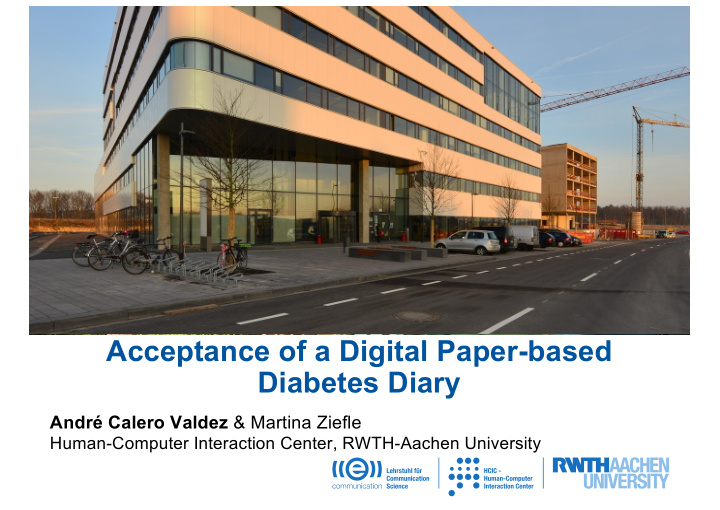



Acceptance of a Digital Paper-based Diabetes Diary André Calero Valdez & Martina Ziefle Human-Computer Interaction Center, RWTH-Aachen University
Diabetes is on the rise • Over 10% of the population now have diabetes, 27% have pre-diabetes • Plethora of additional costs - Damages to § nervous system § cardiovascular system • Therapy requires - Adherence - Tracking of progress (diary) • Therapy is replacement for cybernetic system: Pancreas
What is the problem? Blood sugar must be in a very tight corridor • The pancreas regulates blood sugar - It decreases blood sugar after meals by secreting insulin - It increases blood sugar after fasting by secreting glucagon • If large amounts of sugar are consumed, large amounts of insulin are secreted - Cells become resistant to this higher dose of insulin - Even more insulin is required to lower the blood sugar - Repeat, until pancreas can no longer secret enough insulin à Diabetes Type 2 • High blood glucose levels, glucose reacts with proteins and lipids - Create advanced-gylcation end-products • Leads to cell-ageing, arterial stiffness, inflammation, etc.
Therapy of Diabetes Application of medicine to reduce blood sugar • Change diet, physical activity, reduce blood sugar intake, supply additional insulin • Challenge: - Every patient is different and reacts differently to food, activity, medicine at different times of days • Diary keeping is used to measure bodily parameters to optimize therapy • Main research focus: - Many older patients do not keep a good diary, if so paper-based - Adoption of technology is diverse • Integrating technology into existing behavior
LiveScribe Diabetes Diary Digital pen-based diary • Livescribe is a pen with an infrared-camera • Tracks what you write with integrated OCR • Has a Microphone and loudspeaker integrated • Extensible using penlets • Requires specialized paper Kapitel 21
LiveScribe Diabetes Diary Digital pen-based diary • The diabetes diary looks like a normal paper-based 120 bs. diary 2IU basal. • But, when using the livescribe pen becomes interactive 9:30 one roll 2bu. 11:00 one hour walking. • Entries are digitally stored pear? 3:00pm forest. • Pen gives recommendations (by voice) • Date entry is customizable (create shorthand) Kapitel 21
User study to evaluate the pen and diary Task-based Study • Seven tasks (4 introductory) - Opening the help function - Writing a sentence (I am taking part in an experiment) – Feedback “Activity logged” - Log a glucose measurement – Feedback 100mg/dl - Log insulin dosage - Log a whole day (what did you eat? What glucose measurements did you recall?) - Use the diary to retrieve nutrition facts - Create and use your own abbreviation • Everything was video-taped for later analysis and qualitative data
Research Questions What determines acceptance of such a device? • Measured variables - Age, Gender - Diabetes Type and duration - Expertise with computerized technology - Computer self efficacy - Task Effectiveness and efficiency - Perceived Ease of Use and Usefulness (TAM Models) - Behavioral Intention
Hypotheses
Sample Description Study in a diabetes clinic + control group • 27 participants • Three age groups - Young M=25, SD=2.7, N=10 - Medium M=34, SD=5.7, N=10 - Older M=62, SD=5.7, N=10 • Diabetics Mean Age M=49, SD=17.7 • Non-Diabetics M=33, SD=12.7 • 11 Male, 16 Female
User Diversity in our Sample High levels of expertise Technology Expertise and Computer Self-Efficacy 6 5 Level of Agreement 4 EHT 3 ECT 2 CSE 1 0 <= 28 29-41 41+ Age Groups
Task Completion More complex tasks were completed less well by older users Task Effectiveness 100% 90% 80% Success Rate (%) Task 1 70% Task 2 60% Task 3 50% 40% Task 4 30% Task 5 20% Task 6 10% Task 7 0% <= 28 29-41 41+ Age Groups
How long do users take? Similar patterns across age groups Task Efficiency 450 400 350 Task 1 Time on Task (s) 300 Task 2 250 Task 3 200 Task 4 150 Task 5 100 Task 6 50 Task 7 0 <= 28 29-41 41+ Age Groups
Prototype Evaluation Very good evaluation of features Means of PEU/PU for Individual Functions 5.21 Printing with Diabetto Desktop 5.19 5.37 Editing with Diabetto Desktop 4.7 5.32 Usage of abbreviations 4.5 5.32 Looking up of nutritional facts 5.08 5.27 Logging of activities 4.88 PU 5.62 Logging of insulin dosage PEU 5 5.62 Logging of consumed BE-units 5.08 5.62 Logging of blood glucose measurements 5.08 5.62 Help function 5.54 1 2 3 4 5 6 Level of Agreement
Acceptance of the digital diary High Behavioral Intention in all user groups Pen Evaluation 6 5 Level of Agreement 4 PEU 3 PU 2 BI 1 0 <= 28 29-41 41+ Age Groups
Hypotheses
Correlation and LR Results Unexpected results
Caveats and Limitations Prototypical Evaluation and User Group • Best case users - Willing to try something new, high technical expertise • Wizard of Oz-Style Experiment, no real “misunderstandings” - Scenario driven research - Some errors occurred in OCR • No long-term evaluation, no real critical incidents - Technology and guided use (an experimenter was present)
Discussion Qualitative Insights • Integration into technology feels very unobtrusive - “It’s just a pen, and it even feels good in my hand.” - “I like the voice, it’s so nice and calm.” • The technology was perceived as ambient and assistive - Hidden inside the pen - It felt “smart” and responsive - No additional things to learn • Integration of technology inside existing processes is helpful! - Minimal change of behavior • No influence of user diversity on acceptance variables
Conclusion Thank you very much for your attention • Diabetes is rising and very costly • Therapy is highly individual and requires “customization” • Digital Diabetes Diary using a Livescribe Pen • Integrates into existing process (Paper-based diary) • No influence of user diversity on acceptance! • Perception of ambient “non-technology”
Recommend
More recommend